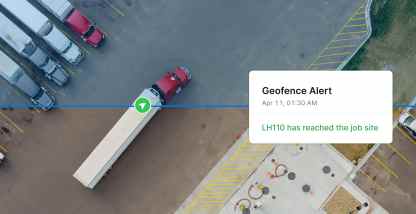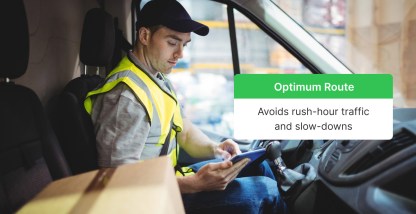In theory, trucking is a simple business. It’s about getting from A to B as efficiently as possible. While consumer-grade GPS navigation solutions have been a big upgrade over paper maps, they often fall short.
Why? The reality of the road for a trucker is anything but simple. Low bridges, weight restrictions, inclement weather, rest stop/truck parking availability, and HOS/ELD compliance are just a few of the many unique challenges faced by truckers.
All of this within one of America’s most competitive industries where efficiency is often the difference between big profits and taking a loss.
Choosing the right truck GPS navigation solution is one of the key ways to keep your business in the black. In this article, we’ll explain:
- What truck GPS navigation is and how it works
- How a truck GPS navigation solution is different
- What the benefits of a truck GPS navigation solution are
- What key GPS navigation features to look for
- Tips to choose the right GPS navigation provider for your business
What is GPS navigation and how does it work?
GPS navigation devices use the Global Positioning System (GPS) system to triangulate a device’s location via signals that bounce back from a network of 24 geosynchronous satellites. Because the GPS system can determine location in real-time, it shows speed and direction as well as location.
When you enter a destination, the GPS navigation system calculates the shortest route from your current location accounting for a number of factors, such as traffic information, construction, and road closures. Often, the GPS navigation system will update the route when turns are missed or new information is obtained (e.g. unexpected traffic).
Truck GPS navigation systems can do this, and much more.
How is a truck-specific GPS navigation system different?
A truck-specific GPS navigation system does everything a consumer solution does and much more. Often, the specs of your truck (height, weight, etc.) are entered into the GPS navigation device. This information is then referenced against a database of truck-relevant road facts such as bridge heights and weight restrictions, among others. Routes that will present an issue for your truck will be avoided.
Truck-specific GPS navigation systems will often make rest stop and truck parking information readily available, simplifying the process of planning compliant routes.
What are the benefits of a truck GPS navigation solution?
A truck-specific GPS navigation solution comes with many benefits, including:
Shorter routes. When routes are optimized, you use less fuel, put less wear and tear on vehicles, and increase customer satisfaction through improved on-time percentages.
Fewer accidents. Staying off roads with low bridges, steep declines, and tight corners can help avoid risky situations.
Improved compliance. A truck-specific GPS navigation can help avoid roads where you’ll exceed the weight limit, accounts for HazMat rules, and help proactively plan rest stops/truck parking to stay HOS/ELD compliant.
What are the key truck GPS navigation features to look for?
While your needs may vary, here are the top features you should be aware of and look for in a truck GPS navigation system.
- Vehicle size/class, bridge, and overpass restrictions
Many roads and bridges have restrictions for height, weight, width, and vehicle classes. Look for a solution that allows you to enter this information to help you avoid roads and bridges that you cannot safely and legally operate on.
- Multiple truck profiles
Several GPS navigation systems are designed to handle multiple truck profiles. This feature works well for drivers that work for a carrier that takes advantage of a slip-seating operation.
- Speeding
Not only is speeding dangerous, speeding tickets damage your CSA score. A truck GPS navigation solution should alert you when you exceed the posted limit.
- Hazmat
If you’re carrying HazMat, you have additional route restrictions than other trucks. Be sure to look for a solution that supports this.
- Traffic updates and alerts
GPS navigation systems designed especially for commercial vehicles give drivers up-to-date alerts and information about detours, traffic accidents, road construction, and other delays. These units can also alert the driver to steep inclines, narrow roads, and sharp curves.
- Rest stops, parking, and other points of interest
A GPS for truck drivers may provide industry-specific coordinates to help the driver locate truck parking, truck stops, weigh stations, towing and repair. This information is in addition to details about rest stops, lodging and healthcare facilities, similar to what you might find on a consumer GPS system.
Additional features to look for when choosing a truck GPS navigation system:
- Bluetooth
- Large display
- Good sound quality
- Lane assist – recommend best lane positioning
- State line crossing alerts
- Screen splitting feature to show off-ramps: aerial directions on one side and ramp approach from the driver’s seat
- Lifetime, over-the-air updates at no additional fees
5 tips to choose the right GPS navigation provider
- Over-the-air updates. Road closures, speed limits, and other key route planning criteria are constantly changing. Be sure to find a solution that updates “over-the-air” via a WiFi or cellular connection and ideally happens automatically.
- No proprietary hardware. Some solutions require you to purchase 3rd party hardware. Not only is this expensive, it restricts you to their ecosystem. Choose a solution that runs on a smartphone or tablet so you have flexibility if your needs change in the future.
- Reviews. There are many review sites that share the experience of current users. Some of the leading ones for truck GPS navigation are Capterra and the Google Play Store.
- A subscription cost. This one may sound odd but stay with us. Quality is key to achieving ROI with a navigation solution. Without a monthly fee, it’s unlikely the provider can invest heavily enough to keep their product updated and accurate. Often, a non-subscription solution is a short-term solution that you’ll soon find won’t meet your needs.
- Integrations. Depending on your business, you may benefit from integrations. For example, the ability to dispatch loads to drivers directly from an online dashboard or view turn-by-turn directions within the Electronic Logging Device interface.
Truck GPS navigation is just the start
A truck GPS navigation solution can bring significant efficiency advantages.
But, it’s just the start. Trucking is one of America’s most competitive industries and there’s so much more a fleet can do to increase profit margins.
That’s where Motive comes in. Motive is the fleet management solution built for modern fleets. With Motive, you can:
- Manage drivers, vehicles, assets from a single dashboard
- Help prevent accidents with dashcams
- Streamline ELD, IFTA, and DVIR compliance
- Help reduce costs such as fuel usage and vehicle maintenance
- Connect your fleet with pre-built integrations, including with leading navigation solutions
- Combat fuel fraud, support compliance, and get better visibility of your fleet operations with real-time GPS vehicle tracking
Learn more about the benefits of what GPS navigation can do — including tracking your assets and geofencing. Or give us a call at 844-325-9230.








